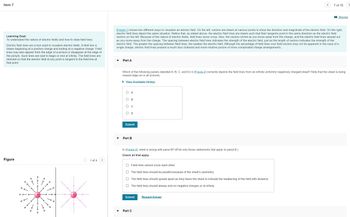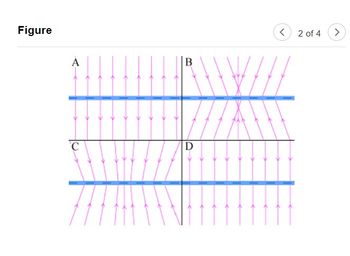
College Physics
11th Edition
ISBN: 9781305952300
Author: Raymond A. Serway, Chris Vuille
Publisher: Cengage Learning
expand_more
expand_more
format_list_bulleted
Concept explainers
Question

Transcribed Image Text:Item 7
Learning Goal:
To understand the nature of electric fields and how to draw field lines.
Electric field lines are a tool used to visualize electric fields. A field line is
drawn beginning at a positive charge and ending at a negative charge. Field
lines may also appear from the edge of a picture or disappear at the edge of
the picture. Such lines are said to begin or end at infinity. The field lines are
directed so that the electric field at any point is tangent to the field line at
that point.
Figure
1 of 4
Part A
(Figure 1) shows two different ways to visualize an electric field. On the left, vectors are drawn at various points to show the direction and magnitude of the electric field. On the right,
electric field lines depict the same situation. Notice that, as stated above, the electric field lines are drawn such that their tangents point in the same direction as the electric field
vectors on the left. Because of the nature of electric fields, field lines never cross. Also, the vectors shrink as you move away from the charge, and the electric field lines spread out
as you move away from the charge. The spacing between electric field lines indicates the strength of the electric field, just as the length of vectors indicates the strength of the
electric field. The greater the spacing between field lines, the weaker the electric field. Although the advantage of field lines over field vectors may not be apparent in the case of a
single charge, electric field lines present a much less cluttered and more intuitive picture of more complicated charge arrangements.
O
Which of the following panels (labelled A, B, C, and D) in (Figure 2) correctly depicts the field lines from an infinite uniformly negatively charged sheet? Note that the sheet is being
viewed edge-on in all pictures.
► View Available Hint(s)
O
A
B
C
D
Submit
Part B
In (Figure 2), what is wrong with panel B? (Pick only those statements that apply to panel B.)
Check all that apply.
Field lines cannot cross each other.
The field lines should be parallel because of the sheet's symmetry.
O The field lines should spread apart as they leave the sheet to indicate the weakening of the field with distance.
The field lines should always end on negative charges or at infinity.
Submit
7 of 15
Part C
Review
Request Answer

Transcribed Image Text:Figure
А
B
D
< 2 of 4
111111
>
Expert Solution
This question has been solved!
Explore an expertly crafted, step-by-step solution for a thorough understanding of key concepts.
This is a popular solution
Trending nowThis is a popular solution!
Step by stepSolved in 2 steps with 2 images

Knowledge Booster
Learn more about
Need a deep-dive on the concept behind this application? Look no further. Learn more about this topic, physics and related others by exploring similar questions and additional content below.Similar questions
- All go together.arrow_forwardy y :P2 B В Figure 2 Figure 1 a. i. Point P1, the intersection of the three bisectors, locates the geometric center of the triangle and is one point where the electric field is zero. On Figure 1 above, draw the electric field vectors EA, EB, and Ec at P1, due to each of the three charges. Be sure your arrows are drawn to reflect the relative magnitude of the fields.arrow_forwardThis is third time I post it all the time given answer was wrong plz give me complete explanation. I definitely upvote youarrow_forward
- Two tiny spheres of mass 8.30 mg carry charges of equal magnitude, 72.0 nC, but opposite sign. They are tied to the same ceiling hook by light strings of length 0.530 m. When a horizontal uniform electric field E that Submit Previous Answers Correct is directed to the left is turned on, the spheres hang at rest with the angle 0 between the strings equal to 58.0° (Figure 1). Part B What is the magnitude E of the field? Express your answer with the appropriate units. Figure 1 of 1 HA a xa X•10" b. E = Value Units L. Submit Previous Answers Request Answer X Incorrect; Try Again; 8 attempts remaining E Provide Feedback 圓arrow_forwardI need help with this physics homework question, thank you!arrow_forwardA charge of 140 μC is at the center of a cube of edge 45.0 cm. No other charges are nearby. (a) Find the flux through each face of the cube. Nm²/c (b) Find the flux through the whole surface of the cube. N . m²/c (c) Would your answers to parts (a) or (b) change if the charge were not at the center? (a) would change. O (b) would change. O Both (a) and (b) would change. O Neither would change.arrow_forward
arrow_back_ios
arrow_forward_ios
Recommended textbooks for you
 College PhysicsPhysicsISBN:9781305952300Author:Raymond A. Serway, Chris VuillePublisher:Cengage Learning
College PhysicsPhysicsISBN:9781305952300Author:Raymond A. Serway, Chris VuillePublisher:Cengage Learning University Physics (14th Edition)PhysicsISBN:9780133969290Author:Hugh D. Young, Roger A. FreedmanPublisher:PEARSON
University Physics (14th Edition)PhysicsISBN:9780133969290Author:Hugh D. Young, Roger A. FreedmanPublisher:PEARSON Introduction To Quantum MechanicsPhysicsISBN:9781107189638Author:Griffiths, David J., Schroeter, Darrell F.Publisher:Cambridge University Press
Introduction To Quantum MechanicsPhysicsISBN:9781107189638Author:Griffiths, David J., Schroeter, Darrell F.Publisher:Cambridge University Press Physics for Scientists and EngineersPhysicsISBN:9781337553278Author:Raymond A. Serway, John W. JewettPublisher:Cengage Learning
Physics for Scientists and EngineersPhysicsISBN:9781337553278Author:Raymond A. Serway, John W. JewettPublisher:Cengage Learning Lecture- Tutorials for Introductory AstronomyPhysicsISBN:9780321820464Author:Edward E. Prather, Tim P. Slater, Jeff P. Adams, Gina BrissendenPublisher:Addison-Wesley
Lecture- Tutorials for Introductory AstronomyPhysicsISBN:9780321820464Author:Edward E. Prather, Tim P. Slater, Jeff P. Adams, Gina BrissendenPublisher:Addison-Wesley College Physics: A Strategic Approach (4th Editio...PhysicsISBN:9780134609034Author:Randall D. Knight (Professor Emeritus), Brian Jones, Stuart FieldPublisher:PEARSON
College Physics: A Strategic Approach (4th Editio...PhysicsISBN:9780134609034Author:Randall D. Knight (Professor Emeritus), Brian Jones, Stuart FieldPublisher:PEARSON

College Physics
Physics
ISBN:9781305952300
Author:Raymond A. Serway, Chris Vuille
Publisher:Cengage Learning

University Physics (14th Edition)
Physics
ISBN:9780133969290
Author:Hugh D. Young, Roger A. Freedman
Publisher:PEARSON

Introduction To Quantum Mechanics
Physics
ISBN:9781107189638
Author:Griffiths, David J., Schroeter, Darrell F.
Publisher:Cambridge University Press

Physics for Scientists and Engineers
Physics
ISBN:9781337553278
Author:Raymond A. Serway, John W. Jewett
Publisher:Cengage Learning

Lecture- Tutorials for Introductory Astronomy
Physics
ISBN:9780321820464
Author:Edward E. Prather, Tim P. Slater, Jeff P. Adams, Gina Brissenden
Publisher:Addison-Wesley

College Physics: A Strategic Approach (4th Editio...
Physics
ISBN:9780134609034
Author:Randall D. Knight (Professor Emeritus), Brian Jones, Stuart Field
Publisher:PEARSON